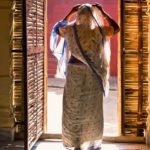When I ask Trinamool Congress MLA, Mahua Moitra, why she loves jamdani sarees, she sends me a poem, written by her college-mate’s uncle, Agha Shahid Ali. In the poem, “The Dacca Gauzes,” jamdani weaves are described as “woven air, running water, evening dew.”
She recites the last line and says, “Isn’t it lovely?”
Clad always in a Bengali weave with her signature sunglasses, Mahua is a picture of glocal (global-local) elegance. She is rooted and stylish. But then, I am biased because Mahua went to my alma mater, Mount Holyoke. And when you are a Mount Holyoke woman, you college-mates become sisters.
Today, Mahua is touted as part of a rising crop of women politicians. She is a regular on television. “I feel truly blessed to be part of Nadia– the land of the jamdani– the weave of life,” she says. “The fabric lets you breathe, lets you move, hug, run, and jump with equal ease as gliding through a royal court.”
Not that Mahua glides through courts on a regular basis. Rather, she is part of the rough and ready world of Bengali politics
The changing ethos of Kolkata
Kolkata today is both changed and unchanged. There are new flyovers being built everyday while political parties jostle over seats. “We demand,” is a common slogan here, even if people disagree about what they are demanding. And yet…..and yet, there is the other Bengal that is unchanging, even eternal. “Bengal truly accepts you for who you are,” says Mahua. “There is no stereotype for what a woman or politician should be like. It is liberating.”
This is the vision that Sabyasachi loves and pays homage to in his flagship store with its dark corridors, candles and archival photos. Sabyasachi’s version of Bengali style is “women in cotton sarees and red lipsticks to match their bold bindi.” His style icons were women like Rekha, who much like Audrey Hepburn, “had a look that didn’t change much.” The same can be applied to the culture that values continuity rather than change.
Three things that bind Bengalis…and now four
“Bengalis are known for three things: nostalgia, dyspepsia and inertia,” pronounces Iti Misra, a home chef who instagrams under the handle @cheffingtonpost.
They are also known for their kasundi (mustard), gondharaj lemons and the jamdani weave. These have been exported out of Bengal to different parts of India and the world.
Mahua feels at home in her native state. And when she travels abroad, or for that matter, anywhere, she simply packs a few Bengali weaves into her suitcase. Lo and behold, she is at home everywhere.





